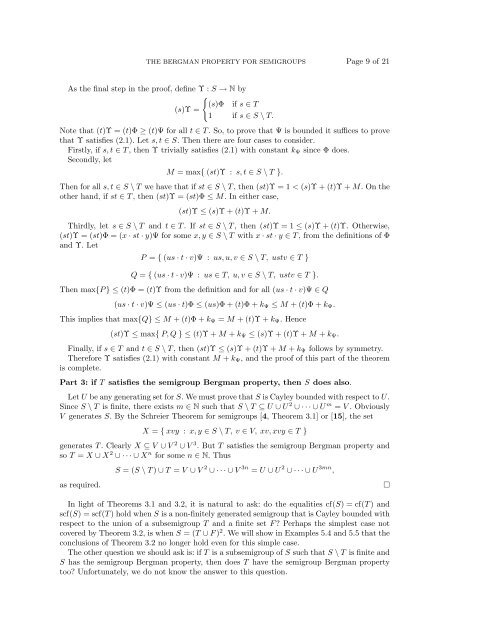The Bergman property for semigroups
The Bergman property for semigroups
The Bergman property for semigroups
Create successful ePaper yourself
Turn your PDF publications into a flip-book with our unique Google optimized e-Paper software.
THE BERGMAN PROPERTY FOR SEMIGROUPS Page 9 of 21<br />
As the final step in the proof, define Υ : S → N by<br />
{<br />
(s)Φ if s ∈ T<br />
(s)Υ =<br />
1 if s ∈ S \ T.<br />
Note that (t)Υ = (t)Φ ≥ (t)Ψ <strong>for</strong> all t ∈ T . So, to prove that Ψ is bounded it suffices to prove<br />
that Υ satisfies (2.1). Let s, t ∈ S. <strong>The</strong>n there are four cases to consider.<br />
Firstly, if s, t ∈ T , then Υ trivially satisfies (2.1) with constant k Ψ since Φ does.<br />
Secondly, let<br />
M = max{ (st)Υ : s, t ∈ S \ T }.<br />
<strong>The</strong>n <strong>for</strong> all s, t ∈ S \ T we have that if st ∈ S \ T , then (st)Υ = 1 < (s)Υ + (t)Υ + M. On the<br />
other hand, if st ∈ T , then (st)Υ = (st)Φ ≤ M. In either case,<br />
(st)Υ ≤ (s)Υ + (t)Υ + M.<br />
Thirdly, let s ∈ S \ T and t ∈ T . If st ∈ S \ T , then (st)Υ = 1 ≤ (s)Υ + (t)Υ. Otherwise,<br />
(st)Υ = (st)Φ = (x · st · y)Ψ <strong>for</strong> some x, y ∈ S \ T with x · st · y ∈ T , from the definitions of Φ<br />
and Υ. Let<br />
P = { (us · t · v)Ψ : us, u, v ∈ S \ T, ustv ∈ T }<br />
Q = { (us · t · v)Ψ : us ∈ T, u, v ∈ S \ T, ustv ∈ T }.<br />
<strong>The</strong>n max{P } ≤ (t)Φ = (t)Υ from the definition and <strong>for</strong> all (us · t · v)Ψ ∈ Q<br />
(us · t · v)Ψ ≤ (us · t)Φ ≤ (us)Φ + (t)Φ + k Ψ ≤ M + (t)Φ + k Ψ .<br />
This implies that max{Q} ≤ M + (t)Φ + k Ψ = M + (t)Υ + k Ψ . Hence<br />
(st)Υ ≤ max{ P, Q } ≤ (t)Υ + M + k Ψ ≤ (s)Υ + (t)Υ + M + k Ψ .<br />
Finally, if s ∈ T and t ∈ S \ T , then (st)Υ ≤ (s)Υ + (t)Υ + M + k Ψ follows by symmetry.<br />
<strong>The</strong>re<strong>for</strong>e Υ satisfies (2.1) with constant M + k Ψ , and the proof of this part of the theorem<br />
is complete.<br />
Part 3: if T satisfies the semigroup <strong>Bergman</strong> <strong>property</strong>, then S does also.<br />
Let U be any generating set <strong>for</strong> S. We must prove that S is Cayley bounded with respect to U.<br />
Since S \ T is finite, there exists m ∈ N such that S \ T ⊆ U ∪ U 2 ∪ · · · ∪ U m = V . Obviously<br />
V generates S. By the Schreier <strong>The</strong>orem <strong>for</strong> <strong>semigroups</strong> [4, <strong>The</strong>orem 3.1] or [15], the set<br />
X = { xvy : x, y ∈ S \ T, v ∈ V, xv, xvy ∈ T }<br />
generates T . Clearly X ⊆ V ∪ V 2 ∪ V 3 . But T satisfies the semigroup <strong>Bergman</strong> <strong>property</strong> and<br />
so T = X ∪ X 2 ∪ · · · ∪ X n <strong>for</strong> some n ∈ N. Thus<br />
as required.<br />
S = (S \ T ) ∪ T = V ∪ V 2 ∪ · · · ∪ V 3n = U ∪ U 2 ∪ · · · ∪ U 3mn ,<br />
In light of <strong>The</strong>orems 3.1 and 3.2, it is natural to ask: do the equalities cf(S) = cf(T ) and<br />
scf(S) = scf(T ) hold when S is a non-finitely generated semigroup that is Cayley bounded with<br />
respect to the union of a subsemigroup T and a finite set F ? Perhaps the simplest case not<br />
covered by <strong>The</strong>orem 3.2, is when S = (T ∪ F ) 2 . We will show in Examples 5.4 and 5.5 that the<br />
conclusions of <strong>The</strong>orem 3.2 no longer hold even <strong>for</strong> this simple case.<br />
<strong>The</strong> other question we should ask is: if T is a subsemigroup of S such that S \ T is finite and<br />
S has the semigroup <strong>Bergman</strong> <strong>property</strong>, then does T have the semigroup <strong>Bergman</strong> <strong>property</strong><br />
too? Un<strong>for</strong>tunately, we do not know the answer to this question.<br />
□
















